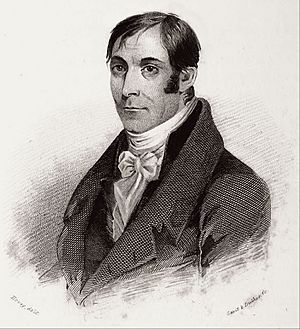Comfort Tyler facts for kids
Quick facts for kids
Comfort Tyler
|
|
|---|---|
 |
|
| Born | February 22, 1764 |
| Died | August 5, 1827 (aged 63) |
| Burial place | Oakwood Cemetery, Syracuse, New York |
| Occupation | Early settler, surveyor and engineer, instrumental in the development of Onondaga County |
| Spouse(s) | Deborah Wemple (died 1785) Elizabeth "Betsey" Brown (died October 21, 1827) |
Comfort Tyler (born February 22, 1764 – died August 5, 1827) was an important early settler in what is now Syracuse, New York. He moved his family to the area in the spring of 1788. This place became known as Onondaga Hollow. It was located south of today's city center, along the future Seneca Turnpike.
Tyler joined Asa Danforth and Ephraim Webster, who were the first white settlers there. They had received permission to live on the land from the Onondaga people. Comfort Tyler built a larger house in Onondaga Hollow. He also used his engineering skills to help develop the entire Central New York region.
Contents
Who Was Comfort Tyler?
Comfort Tyler was a pioneer, which means he was one of the first people to settle in a new area. He played a big part in shaping the early days of Onondaga County, New York. This county is where the city of Syracuse is located today.
He was not just a settler; he was also a skilled surveyor and engineer. This means he helped measure land and design important structures. His work was key to building roads and communities in the growing region.
Early Life and Moving to New York
Comfort Tyler was born on February 22, 1764, in Ashford, Connecticut. Not much is known about his early childhood. As a young man, he decided to move west to find new opportunities.
In 1788, he brought his family to the area that would become Onondaga Hollow. This was a brave move, as the land was mostly wilderness at the time. Settlers like Tyler helped create the first towns and farms.
Building a Community
When Comfort Tyler arrived, he joined other early settlers like Asa Danforth and Ephraim Webster. These men had already talked with the Onondaga people, who were the native inhabitants of the land. The Onondaga people gave them permission to live there.
Tyler quickly became a leader in the new settlement. He built a more impressive house than others in Onondaga Hollow. This showed his commitment to making the area a permanent home.
Tyler's Engineering Skills
Comfort Tyler was known for his engineering abilities. In the late 1700s and early 1800s, engineers were crucial for building new towns. They helped plan roads, bridges, and other important structures.
His skills were very valuable in developing Central New York. He likely helped lay out the paths that would become major roads. One important road was the Seneca Turnpike, which connected many early settlements.
Later Life and Legacy
Comfort Tyler continued to be an important figure in Onondaga County. He saw the small settlement of Onondaga Hollow grow into a thriving area. His work helped pave the way for the future city of Syracuse.
He passed away on August 5, 1827, in Montezuma, New York. He was buried in Oakwood Cemetery in Syracuse. Comfort Tyler is remembered as one of the key founders of modern Syracuse. His efforts helped build the foundation for the community that exists today.

